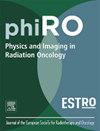Feasibility of Monte Carlo-based patient-specific quality assurance in 1.5 Tesla magnetic resonance-guided online adaptive radiotherapy: a multi-institutional study
IF 3.3
Q2 ONCOLOGY
引用次数: 0
Abstract
Introduction
To evaluate the feasibility of Monte Carlo (MC)-based patient-specific quality assurance (PSQA) for MR-guided online adaptive radiotherapy and to explore the potential to eliminate the post-delivery measurement-based PSQA.
Material and methods
A total of 113 cases from two institutions, treated on MR-Linac machines, were included in the study. A customized GPU-accelerated, Monte Carlo-based secondary dose verification software (ART2Dose) was developed and integrated into the QA workflow, accounting for a 1.5 Tesla magnetic field. PSQA included ArcCheck (AC) delivery QA and online MC calculation-based QA. Reference plans underwent offline validation with AC and MC, while adapt-to-shape (ATS) plans were processed through MC and post-delivery QA. Gamma pass rates (GPR) with 3 %/2mm criteria were compared statistically across methods. Radcalc was applied to compare point dose difference with MC.
Results
MC QA achieved GPRs of 97.5 % ± 2.0 % and 97.1 % ± 2.9 % for reference and ATS plans, comparable to AC QA (97.6 % ± 2.0 % and 96.9 % ± 3.0 %). Wilcoxon signed-rank test showed statistically significant differences between reference and ATS plan QA (p < 0.05), but a Pearson correlation coefficient of 0.76 confirmed a linear relationship for MC GPR. Lung cases exhibited lower GPRs with MC compared to AC QA. MC QA demonstrated supaireerior point dose agreement with TPS (1.7 % ± 1.2 %) compared to RadCalc (4.1 % ± 1.7 %). No significant differences were observed between institutions.
Conclusion
MC-based QA is a robust tool for adaptive QA workflows in 1.5-T MR-Linac systems. It enhances efficiency and potentially supports the elimination of post-delivery measurement-based QA for adaptive plans.
基于蒙特卡罗的患者特异性质量保证在1.5特斯拉磁共振引导在线自适应放疗中的可行性:一项多机构研究
目的:评估基于蒙特卡罗(MC)的患者特异性质量保证(PSQA)用于磁共振引导在线适应性放疗的可行性,并探讨消除基于分娩后测量的PSQA的可能性。材料与方法来自两家机构的113例病例,均采用MR-Linac机器治疗。开发了一款定制的gpu加速、基于蒙特卡罗的二次剂量验证软件(ART2Dose),并将其集成到QA工作流程中,占1.5特斯拉磁场。PSQA包括ArcCheck (AC)交付QA和基于在线MC计算的QA。参考方案通过AC和MC进行离线验证,而形状适应(ATS)方案通过MC和产后QA进行处理。以3% /2mm为标准的伽玛通过率(GPR)在不同方法中进行统计学比较。结果smc QA参考和ATS方案的GPRs分别为97.5%±2.0%和97.1%±2.9%,与AC QA(97.6%±2.0%和96.9%±3.0%)相当。Wilcoxon sign -rank检验显示参考文献与ATS计划QA之间存在统计学差异(p <;0.05),但Pearson相关系数为0.76,证实了MC - GPR的线性关系。与AC QA相比,MC组肺部GPRs较低。MC QA与TPS的点剂量一致性(1.7%±1.2%)优于RadCalc(4.1%±1.7%)。不同机构间无显著差异。结论基于mc的QA是1.5 t MR-Linac系统自适应QA工作流程的强大工具。它提高了效率,并潜在地支持消除基于交付后度量的自适应计划的QA。
本文章由计算机程序翻译,如有差异,请以英文原文为准。
求助全文
约1分钟内获得全文
求助全文
来源期刊

Physics and Imaging in Radiation Oncology
Physics and Astronomy-Radiation
CiteScore
5.30
自引率
18.90%
发文量
93
审稿时长
6 weeks
 求助内容:
求助内容: 应助结果提醒方式:
应助结果提醒方式:


